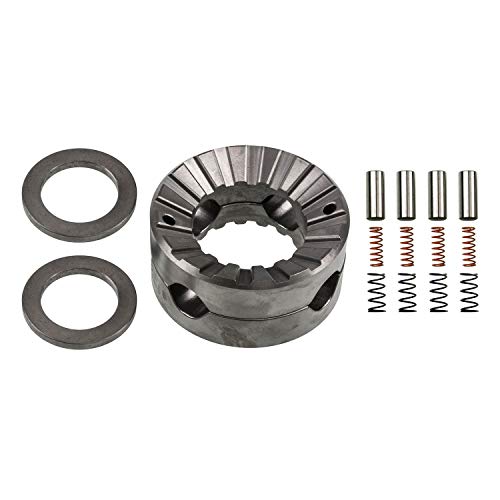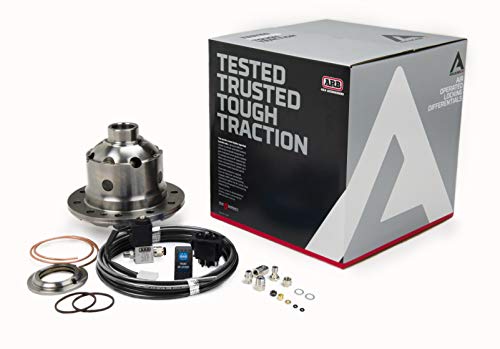Explore the definition, , and working mechanism of locking differentials, along with tips for optimal performance in your vehicle.
Definition of Locking Differential
Functionality
A locking differential, also known as a locker, is a crucial component in a vehicle’s drivetrain system. Its primary function is to ensure that power is evenly distributed to both wheels on an axle, regardless of the traction conditions. This means that when one wheel loses traction, the locking differential locks both wheels together, allowing them to spin at the same speed. This is particularly useful in off-road situations where one wheel may be on a slippery surface while the other is on solid ground.
Types
There are several of locking differentials available on the market, each with its own unique characteristics and . The most common include:
- Mechanical Locking Differential: This type of differential uses mechanical components, such as gears or clutch packs, to physically lock the two wheels together. It provides maximum traction in challenging off-road conditions but may be less suitable for everyday driving due to potential binding issues.
- Automatic Locking Differential: An automatic locking differential engages automatically when one wheel starts to slip, providing instant traction without the need for driver intervention. This type is ideal for novice off-road enthusiasts or those who want a hassle-free driving experience.
- Selectable Locking Differential: A selectable locking differential allows the driver to manually engage or disengage the locking mechanism, giving them more control over when to use the extra traction. This type is popular among experienced off-road drivers who prefer a more hands-on approach to their vehicle’s performance.
Benefits of Locking Differential
Improved Traction
When it comes to driving off-road or in challenging terrain, having improved traction can make all the difference. A locking differential is designed to provide equal power to both wheels, allowing them to rotate at the same speed. This helps prevent one wheel from spinning out while the other remains stationary, giving you better control and grip on uneven surfaces. With improved traction, you can navigate through mud, snow, rocks, and other obstacles with ease, knowing that your vehicle can handle whatever comes its way.
Enhanced Off-Road Performance
In addition to improved traction, a locking differential also enhances your vehicle’s off-road performance in various ways. By allowing both wheels to receive power equally, you can tackle steep inclines, rocky terrain, and deep mud without getting stuck. The increased stability and control provided by a locking differential give you the confidence to push your vehicle to its limits and explore new off-road challenges. Whether you’re a seasoned off-road enthusiast or a beginner looking to venture off the beaten path, having a locking differential can significantly enhance your driving experience.
Overall, the of a locking differential extend beyond just traction and performance. It can also improve your vehicle’s overall handling and stability, making it a valuable upgrade for any off-road enthusiast or adventurous driver. So, if you’re looking to take your off-road adventures to the next level, consider investing in a locking differential for your vehicle.
How Locking Differential Works
The locking differential is a crucial component in a vehicle’s drivetrain that plays a significant role in improving traction and overall performance, especially in conditions. Understanding how this mechanism operates and the various activation methods is essential for any driver looking to maximize their vehicle’s capabilities.
Mechanism
At its core, a locking differential is designed to ensure that power is distributed evenly to both wheels, regardless of the traction conditions. Unlike an open differential that allows wheels to spin independently, a locking differential locks the two wheels together, forcing them to rotate at the same speed. This feature is particularly useful in situations where one wheel may lose , such as when navigating through muddy terrain or climbing steep hills.
To visualize this concept, think of a locking differential as a set of gears that are engaged to prevent one wheel from spinning faster than the other. When both wheels are locked together, they work in unison to propel the vehicle forward, providing maximum traction and stability.
Activation Methods
There are several methods for activating a locking differential, depending on the type of vehicle and the specific model. One common method is manual engagement, where the driver has the option to lock or unlock the differential using a switch or lever inside the cabin. This allows the driver to control when the locking mechanism is activated, providing flexibility in different driving scenarios.
Another popular activation method is automatic locking differentials, which utilize sensors to detect wheel slippage and engage the locking mechanism automatically. This hands-free approach is convenient for drivers who prefer a set-it-and-forget-it solution, as the differential will engage when needed without any input from the driver.
In summary, the mechanism of a locking differential ensures equal power distribution to both wheels, while activation methods vary between manual and automatic options. Understanding how these components work together is essential for maximizing traction and performance in challenging driving conditions.
Differences Between Locking Differential and Limited-Slip Differential
When it comes to choosing between a locking differential and a limited-slip differential, understanding the differences in performance and application is crucial. Let’s dive into the key distinctions between these two of differentials.
Performance
- Locking Differential:
- Provides maximum traction to both wheels simultaneously.
- Ideal for off-road situations where one wheel may lose traction.
- Offers superior performance in extreme conditions such as rock crawling or deep mud.
- Can cause drivetrain binding on high-traction surfaces like pavement.
- Limited-Slip Differential:
- Transfers power to the wheel with the most traction.
- Balances power distribution between wheels for better handling.
- Provides improved performance in everyday driving situations.
- May not be as effective in off-road or extreme conditions compared to a locking differential.
In terms of performance, the locking differential excels in scenarios where maximum traction is needed, such as navigating through challenging off-road terrain. On the other hand, the limited-slip differential offers a more balanced approach, enhancing handling and stability in everyday driving conditions.
Application
- Locking Differential:
- Commonly found in hardcore off-road vehicles and trucks.
- Recommended for enthusiasts who frequently encounter challenging terrain.
- Not typically used in everyday commuter vehicles due to potential drivetrain binding.
- Limited-Slip Differential:
- Widely used in performance cars and sports vehicles.
- Provides a good balance between traction and handling on paved roads.
- Suitable for drivers seeking improved stability during cornering and acceleration.
When it comes to application, the choice between a locking differential and a limited-slip differential depends on the intended use of the vehicle. Off-road enthusiasts and hardcore adventurers may opt for a locking differential for its superior traction capabilities, while performance car enthusiasts may prefer the balanced performance of a limited-slip differential on the road.
Maintenance Tips for Locking Differential
Regular of your locking differential is crucial to ensure optimal performance and longevity. In this section, we will discuss two essential tips: fluid change and regular inspection.
Fluid Change
One of the most important aspects of maintaining a locking differential is regular fluid changes. The differential fluid plays a vital role in lubricating the gears and components inside the differential, reducing friction and heat buildup. Over time, the fluid can break down and become contaminated with debris, causing it to lose its effectiveness.
To ensure your locking differential continues to function properly, it is recommended to follow the manufacturer’s guidelines for fluid change intervals. Typically, this involves draining the old fluid from the differential and refilling it with fresh, clean fluid. This process helps to remove any debris or contaminants that may have accumulated in the differential, preventing potential damage to the gears and other components.
When performing a fluid change, it is essential to use the correct type of differential fluid recommended by the manufacturer. Using the wrong type of fluid can lead to decreased performance and potential damage to the differential. Additionally, be sure to check for any signs of leaks or damage to the differential housing during the fluid change process.
- Regularly check the differential fluid level and condition.
- Follow the manufacturer’s guidelines for fluid change intervals.
- Use the correct type of differential fluid recommended by the manufacturer.
- Inspect for leaks or damage to the differential housing during fluid changes.
Regular Inspection
In addition to regular fluid changes, conducting routine inspections of your locking differential is essential to catch any potential issues early on and prevent costly repairs down the line. Regular inspections can help identify worn or damaged components, leaks, or other issues that may affect the performance of your differential.
During a regular inspection, visually inspect the differential housing for any signs of leaks, cracks, or damage. Check the mounting bolts and brackets to ensure they are secure and in good condition. Additionally, listen for any unusual noises coming from the differential while driving, as this could indicate a problem with the gears or other internal components.
It is also recommended to have a professional mechanic inspect your locking differential at least once a year or more frequently if you use your vehicle in harsh conditions such as off-roading or towing. A trained technician can perform a more thorough inspection, including checking the gear teeth for wear, testing the engagement of the locking , and verifying that all components are functioning correctly.
- Visually inspect the differential housing for leaks, cracks, or damage.
- Check the mounting bolts and brackets for security and condition.
- Listen for any unusual noises coming from the differential.
- Have a professional mechanic inspect the locking differential at least once a year.
By following these tips for your locking differential, you can ensure that it continues to provide optimal performance and reliability for years to come. Regular fluid changes and inspections are simple yet crucial steps to keep your differential in top condition, whether you’re tackling off-road terrain or simply cruising on the highway. Remember, a well-maintained locking differential is a happy differential!



